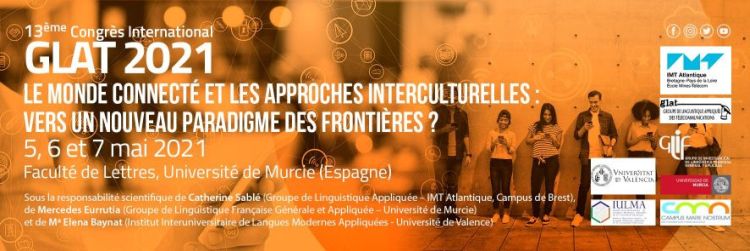|
The connected world and intercultural approaches : towards a new border paradigm ? GLAT 2021 : May 5-7 On-Line Colloquium THE CONNECTED WORLD AND INTERCULTURAL APPROACHES: TOWARD A NEW BORDER PARADIGM? Faculty of Letters, University of Murcia (Spain) 13th International GLAT Congress chaired by Catherine Sablé (Group of Applied Linguistics - IMT Atlantique), Mercedes Eurrutia (Group of General and Applied French Linguistics - University of Murcia) and Mª Elena Baynat (Interuniversity Institute of Applied Modern Languages – University of Valencia) As a result of technological progress and changes in contemporary societies, we are living in an era in which two phenomena stand out. On the one hand, a new perspective is emerging towards an intercultural society that affirms the need for common norms and language, based on the recognition of cultural diversity, openness to different cultural groups and the acceptance of change. On the other hand, we are also living in a society in which information and communication technologies have taken a decisive place, particularly in the field of learning and intercultural competence, i.e., in the "way of analyzing cultural diversity" (Meunier, 2007). Interculturality goes beyond a simple comparison and/or identification with another cultural group. It allows us to build bridges between cultures with the aim of exchange and mutual enrichment, while opening up a new perspective: that of intersecting views. Indeed, the concept of intercultural competence presupposes knowledge and skills of a linguistic nature, but also of a social and/or anthropological bent, adding a much broader dimension to the notion of culture. The individual is positioned as a social being and one of the main actors of his or her culture, going beyond a mere product. In this context, language and culture become "a stage for oneself and the other" (Abdallah Pretceille, 1999). What becomes of this performance in this permanently connected world, i.e. continually going through mediation as a "process of behavioural transformation brought about by the use of technology" Burton et al. 2011)? Today, if we look at multiple fields that either are intended to be or simply appear to be ideal vectors for intercultural training, we can see that intercultural society, to use Verbunt’s title (2005), is ambiguous. Thus, the same media spaces that foster intercultural relations or allow the construction of a global culture, such as the many European projects (training, research) and international economic agreements, also seem to promote ideological manipulation. Interculturalism becomes violence, recalling Demorgon's words: "Voluntary interculturality cannot ignore the fact that it is linked to factual interculturality, peaceful or violent" (2003: 45). Can we still refer to interculturality when it involves being closed off from the Other, when it accepts without question what Carroll (1991) calls the "invisible obvious"?
The objective of GLAT 2020 is to use an interdisciplinary and multilingual approach to question those connected spaces that promote the common within diversities, in order to understand which representations and paradigms on interculturality and relations to the Other these spaces seek to develop. For this 13th edition of the GLAT international conference, one round table will be added to the invited talks and papers. Submissions may be drawn from the following five thematic areas: THEMATIC AXES I. Applied Linguistics and ICT: new intercultural exchanges
II. Interculturality and ICT: new linguistic and literary approaches
III. Intercultural dialogue and ICT: Lexicology, terminology and lexicography
IV. Towards a new didactics of languages and cultures using ICT
V. Sociological, anthropological, cultural approach in a connected world
BIBLIOGRAPHY
|
| Online user: 4 | Privacy |

|

